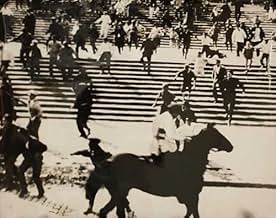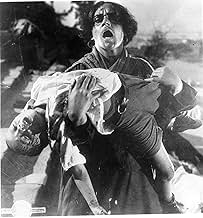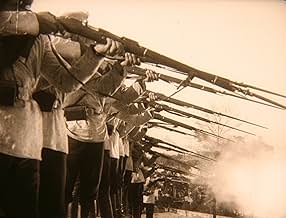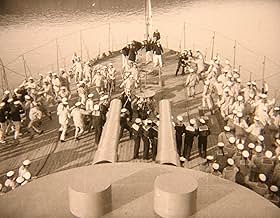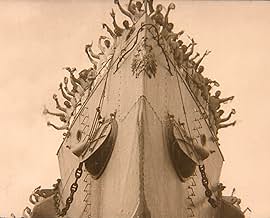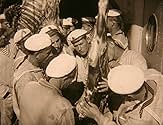PUNTUACIÓN EN IMDb
7,9/10
64 mil
TU PUNTUACIÓN
En plena Revolución rusa de 1905, la tripulación del acorazado Potemkin se amotina contra el régimen brutal y tiránico de los oficiales del buque. La manifestación callejera resultante en Od... Leer todoEn plena Revolución rusa de 1905, la tripulación del acorazado Potemkin se amotina contra el régimen brutal y tiránico de los oficiales del buque. La manifestación callejera resultante en Odesa provoca una masacre policial.En plena Revolución rusa de 1905, la tripulación del acorazado Potemkin se amotina contra el régimen brutal y tiránico de los oficiales del buque. La manifestación callejera resultante en Odesa provoca una masacre policial.
- Director/a
- Guionistas
- Estrellas
- Premios
- 1 premio en total
Ivan Bobrov
- Young Sailor Flogged While Sleeping
- (as I. Bobrov)
Nina Poltavtseva
- Woman With Pince-nez
- (as N. Poltavtseva)
Iona Biy-Brodskiy
- Student
- (as Brodsky)
Sergei Eisenstein
- Odessa Citizen
- (as Sergei M. Eisenstein)
Andrey Fayt
- Recruit
- (as A. Fait)
7,964.4K
1
2
3
4
5
6
7
8
9
10
Resumen
Reviewers say 'Battleship Potemkin' is acclaimed for its pioneering montage and editing, significantly impacting cinema. The 1905 Russian Revolution portrayal, especially the Odessa Steps scene, is lauded for its potent visuals and emotional resonance. Many praise its technical innovations and contribution to filmmaking. However, some criticize its political propaganda and shallow character development. Nonetheless, 'Battleship Potemkin' is widely recognized as a cinematic masterpiece and a vital historical film.
Reseñas destacadas
Vivid & Memorable
This classic is filled with vivid images that stay in your mind after you have watched it, and there is a lot to appreciate in the way that the key scenes were set up and photographed. The visuals are so impressive that the movie's imperfections are usually not so noticeable, and they don't keep it from being a memorable film.
The movie certainly deserves the praise that it gets both for the influence that it has had, and for some ideas that for the time were most creative. The famed 'Odessa Steps' sequence alone demonstrates both fine technical skill and a keen awareness of how to drive home an image to an audience. It deserves to be one of cinema's best remembered sequences. Some of the other scenes also demonstrate, to a lesser degree, the same kind of skill.
It says a lot for how effective all of the visuals are that so many viewers think so highly of "Battleship Potemkin" despite a story that is sometimes heavy-handed, and despite characters and acting that are both rather thin. These features might simply stem from the collectivist philosophy that lies behind the story, and they are obscured most of the time by Eisenstein's unsurpassed ability to present pictures that viewers will not forget.
Despite the flaws, this is a movie that most fans of silent films, and anyone interested in the history of movies, will want to see. There's nothing else in its era that's quite like it.
The movie certainly deserves the praise that it gets both for the influence that it has had, and for some ideas that for the time were most creative. The famed 'Odessa Steps' sequence alone demonstrates both fine technical skill and a keen awareness of how to drive home an image to an audience. It deserves to be one of cinema's best remembered sequences. Some of the other scenes also demonstrate, to a lesser degree, the same kind of skill.
It says a lot for how effective all of the visuals are that so many viewers think so highly of "Battleship Potemkin" despite a story that is sometimes heavy-handed, and despite characters and acting that are both rather thin. These features might simply stem from the collectivist philosophy that lies behind the story, and they are obscured most of the time by Eisenstein's unsurpassed ability to present pictures that viewers will not forget.
Despite the flaws, this is a movie that most fans of silent films, and anyone interested in the history of movies, will want to see. There's nothing else in its era that's quite like it.
Like Citizen Kane it's almost been TOO analyzed and cherished as a landmark, but still not without good reason
If you're a film student, or were one, or are thinking of becoming one, the name Battleship Potemkin has or will have a resonance. Sergei Eistenstein, like other silent-film pioneers like Griffith (although Eisenstein's innovations are not as commonplace as Griffith's) and Murnau, has had such an impact on the history of cinema it's of course taken for granted. The reason I bring up the film student part is because at some point, whether you'd like it or not, your film professor 9 times out of 10 will show the "Odessa Stairs" sequence of this film. It's hard to say if it's even the 'best' part of the film's several sequences dealing with the (at the time current) times of the Russian revolution. But it does leave the most impact, and it can be seen in many films showcasing suspense, or just plain montage (The Untouchables' climax comes to mind).
Montage, which was not just Eistenstein's knack but also his life's blood early in his career, is often misused in the present cinema, or if not misused then in an improper context for the story. Sometimes montage is used now as just another device to get from point A to point B. Montage was something else for Eisenstein; he was trying to communicate in the most direct way that he could the urgency, the passion(s), and the ultimate tragedies that were in the Russian people at the time and place. Even if one doesn't see all of Eisenstein's narrative or traditional 'story' ideas to have much grounding (Kubrick has said this), one can't deny the power of seeing the ships arriving at the harbor, the people on the stairs, and the soldiers coming at them every which way with guns. Some may find it hard to believe this was done in the 20's; it has that power like the Passion of Joan of Arc to over-pass its time and remain in importance if only in terms of technique and emotion.
Of course, one could go on for books (which have been written hundreds of times over, not the least of which by Eisenstein himself). On the film in and of itself, Battleship Potemkin is really more like a dramatized newsreel than a specific story in a movie. The first segment is also one of the great sequences in film, as a mutiny is plotted against the Captain and other head-ups of a certain Ship. This is detailed almost in a manipulative way, but somehow extremely effective; montage is used here as well, but in spurts of energy that capture the eye. Other times Eisenstein is more content to just let the images speak for themselves, as the soldiers grow weary without food and water. He isn't one of those directors who will try to get all sides to the story; he is, of course, very much early 20th century Russian, but he is nothing else but honest with how he sees his themes and style, and that is what wins over in the end.
Some may want to check it outside of film-school, as the 'Stairs' sequence is like one of those landmarks of severe tragedy on film, displaying the ugly side of revolution. Eisenstein may not be one of the more 'accessible' silent-film directors, but if montage, detail in the frame, non-actors, and Bolshevik themes are your cup of tea, it's truly one of the must sees of a lifetime.
Montage, which was not just Eistenstein's knack but also his life's blood early in his career, is often misused in the present cinema, or if not misused then in an improper context for the story. Sometimes montage is used now as just another device to get from point A to point B. Montage was something else for Eisenstein; he was trying to communicate in the most direct way that he could the urgency, the passion(s), and the ultimate tragedies that were in the Russian people at the time and place. Even if one doesn't see all of Eisenstein's narrative or traditional 'story' ideas to have much grounding (Kubrick has said this), one can't deny the power of seeing the ships arriving at the harbor, the people on the stairs, and the soldiers coming at them every which way with guns. Some may find it hard to believe this was done in the 20's; it has that power like the Passion of Joan of Arc to over-pass its time and remain in importance if only in terms of technique and emotion.
Of course, one could go on for books (which have been written hundreds of times over, not the least of which by Eisenstein himself). On the film in and of itself, Battleship Potemkin is really more like a dramatized newsreel than a specific story in a movie. The first segment is also one of the great sequences in film, as a mutiny is plotted against the Captain and other head-ups of a certain Ship. This is detailed almost in a manipulative way, but somehow extremely effective; montage is used here as well, but in spurts of energy that capture the eye. Other times Eisenstein is more content to just let the images speak for themselves, as the soldiers grow weary without food and water. He isn't one of those directors who will try to get all sides to the story; he is, of course, very much early 20th century Russian, but he is nothing else but honest with how he sees his themes and style, and that is what wins over in the end.
Some may want to check it outside of film-school, as the 'Stairs' sequence is like one of those landmarks of severe tragedy on film, displaying the ugly side of revolution. Eisenstein may not be one of the more 'accessible' silent-film directors, but if montage, detail in the frame, non-actors, and Bolshevik themes are your cup of tea, it's truly one of the must sees of a lifetime.
Possibly the most influential film of all time
A milestone in cinematic history, 'Bronenosets Potyomkin' is one of the handful of great films out there that richly deserves to be called a classic. It was the picture that made Sergei M. Eisenstein a figurehead of film-making at the time. And today, it is still remembered as the wonderful piece of cinema it always has been.
'Potyomkin' is a film that NEEDS to be seen as one entity, not to be picked at. Don't just watch those clip shows where they only present the 'Odessa steps' sequence and then move on to 'Citizen Kane' or 'The Godfather', see it all in it's glorious 75-minute running time to really understand and enjoy it. Don't expect every infinitesimal detail to be perfect though, I mean the acting of the '20s silent era makes 'Scooby Doo' look like a master of understated realism, certain plot points may seem illogical and some of the battle sequences look dated, but it is still an immensely enjoyable movie.
The most memorable moments in the film are the mutiny on the battleship, Vakulinchuk's body falling off the ship, the sailor under the tent at the end of the pier, the mother holding her dead child, the baby carriage on the Odessa steps and the lion rising up to roar as further carnage ensues. For each new pair of eyes that look upon it, 'The Battleship Potemkin' comes alive once again.
'Potyomkin' is a film that NEEDS to be seen as one entity, not to be picked at. Don't just watch those clip shows where they only present the 'Odessa steps' sequence and then move on to 'Citizen Kane' or 'The Godfather', see it all in it's glorious 75-minute running time to really understand and enjoy it. Don't expect every infinitesimal detail to be perfect though, I mean the acting of the '20s silent era makes 'Scooby Doo' look like a master of understated realism, certain plot points may seem illogical and some of the battle sequences look dated, but it is still an immensely enjoyable movie.
The most memorable moments in the film are the mutiny on the battleship, Vakulinchuk's body falling off the ship, the sailor under the tent at the end of the pier, the mother holding her dead child, the baby carriage on the Odessa steps and the lion rising up to roar as further carnage ensues. For each new pair of eyes that look upon it, 'The Battleship Potemkin' comes alive once again.
This is a cinematic masterpiece, way ahead of its time.
There are only a handful of movies that were made on such a grand scale and made such a difference in the art of movie making.
"Bronenosets Potyomkin" is one of these movies, and it should be on anyone's list looking to learn more about the history of cinema.
Grigori Aleksandrov & Sergei M. Eisenstein directed this groundbreaking film that documents the horrors taking place on a Russian battleship. When the sailors finally retaliate against their superiors, the locals embrace the them, and support them. Things get ugly when a group of soldiers are sent to the small town to take care of business. What follows is one of the most imitated scenes in the history of cinema. Anyone who has seen "The Untouchables", and "Bronenosets Potyomkin" knows exactly what I mean.
Overall I think this movie raised the bar for film making just as "Intolerance" did a few years earlier. If you do not mind silent films, do yourself a favor, and see "Bronenosets Potyomkin".
If you don't like silent films..... watch "Bronenosets Potyomkin" anyway.
"Bronenosets Potyomkin" is one of these movies, and it should be on anyone's list looking to learn more about the history of cinema.
Grigori Aleksandrov & Sergei M. Eisenstein directed this groundbreaking film that documents the horrors taking place on a Russian battleship. When the sailors finally retaliate against their superiors, the locals embrace the them, and support them. Things get ugly when a group of soldiers are sent to the small town to take care of business. What follows is one of the most imitated scenes in the history of cinema. Anyone who has seen "The Untouchables", and "Bronenosets Potyomkin" knows exactly what I mean.
Overall I think this movie raised the bar for film making just as "Intolerance" did a few years earlier. If you do not mind silent films, do yourself a favor, and see "Bronenosets Potyomkin".
If you don't like silent films..... watch "Bronenosets Potyomkin" anyway.
The working, collective eye
I don't recommend that you see this as a 'landmark' in film; don't merely pass through to say you did, or because it's a travelled destination for most people. Instead, come to this with fresh eyes if you can. Rarely since has a film - and film tradition - been so deeply centered within its worldview, rarely indeed is a film made of the very fabric of the world it gives voice to. Most films these days are built at random, or from random spare parts.
Eisenstein had already made a more successful film before this, more reflexively about the seeing eye. So, even though there is a more rip-roaring story here, you may have to struggle a bit with how faceless appears this world to us, these days so accustomed to the paradigm of the individual hero. But Eisenstein was an architect - literally, as well as in film - and so space matters, our relationship with space through motion matters.
In other words; this may have been preserved to us as a museum piece, which is an indictment of our own understanding of cinema as coming down to us by the books and lists of assorted institutions, but at the time it was part of the most deeply revolutionary film school, one that rigged trains as movie studios and sent them scurrying the countryside to film the people and show them to themselves. I mean, here was a man - Eisenstein - who studied Japanese ideograms to understand synthesized image; who discovered that editing to the beats of the human heart affected more, true or false it shows the desire to both know and reach out.
Our cinematic ideas have mostly regressed into mechanical reproduction since the time when these things were first engineered. Oh, there's plenty of Eisenstein every time you open the TV, but none of it is knowing. It's merely a matter of going-through-the-motions, without the blueprint anymore.
So, look at how crowds are orchestrally conducted through stark geometries, how Eisenstein dissects cinematic space with even a stationary camera. But this type of cinema meant to agitate the people, was never about a thought, it was about an action.
And so with this one. There is the one hero who, although dead, calls out to the people. They rush to him, like ships around their harbor. So on board the ship there is valiant effort for brotherhood and justice, inspired revolution; portside is the motherland, cheering the effort with aplomb. And in the end there is the hero ship, itself filled with heroes, now passing through a sea corridor lined with brother ships, all cheering the one. You can imagine the people cheering at the cinema, who had been there to cheer the real thing years ago.
And when I say 'the real thing' I mean the revolution 8 years before; the Potemkin event depicted here was purely fictional. Yet by the famous steps at Odessa is erected a monument to the fictional sailors, what better example of cinema shaping reality?
So yes, it is a revolutionary film. We may be inclined to make fun of the notions, or worse yet dismiss off-hand because of hindsight knowledge. But this was a film celebrating a time when the world seemed like it could be new again. Then came Stalin and, ironically, vanished all these filmmakers that sung the paeans.
Eisenstein had already made a more successful film before this, more reflexively about the seeing eye. So, even though there is a more rip-roaring story here, you may have to struggle a bit with how faceless appears this world to us, these days so accustomed to the paradigm of the individual hero. But Eisenstein was an architect - literally, as well as in film - and so space matters, our relationship with space through motion matters.
In other words; this may have been preserved to us as a museum piece, which is an indictment of our own understanding of cinema as coming down to us by the books and lists of assorted institutions, but at the time it was part of the most deeply revolutionary film school, one that rigged trains as movie studios and sent them scurrying the countryside to film the people and show them to themselves. I mean, here was a man - Eisenstein - who studied Japanese ideograms to understand synthesized image; who discovered that editing to the beats of the human heart affected more, true or false it shows the desire to both know and reach out.
Our cinematic ideas have mostly regressed into mechanical reproduction since the time when these things were first engineered. Oh, there's plenty of Eisenstein every time you open the TV, but none of it is knowing. It's merely a matter of going-through-the-motions, without the blueprint anymore.
So, look at how crowds are orchestrally conducted through stark geometries, how Eisenstein dissects cinematic space with even a stationary camera. But this type of cinema meant to agitate the people, was never about a thought, it was about an action.
And so with this one. There is the one hero who, although dead, calls out to the people. They rush to him, like ships around their harbor. So on board the ship there is valiant effort for brotherhood and justice, inspired revolution; portside is the motherland, cheering the effort with aplomb. And in the end there is the hero ship, itself filled with heroes, now passing through a sea corridor lined with brother ships, all cheering the one. You can imagine the people cheering at the cinema, who had been there to cheer the real thing years ago.
And when I say 'the real thing' I mean the revolution 8 years before; the Potemkin event depicted here was purely fictional. Yet by the famous steps at Odessa is erected a monument to the fictional sailors, what better example of cinema shaping reality?
So yes, it is a revolutionary film. We may be inclined to make fun of the notions, or worse yet dismiss off-hand because of hindsight knowledge. But this was a film celebrating a time when the world seemed like it could be new again. Then came Stalin and, ironically, vanished all these filmmakers that sung the paeans.
¿Sabías que...?
- CuriosidadesThe flag seen flying on the ship after the crew had mutinied is white, which is the color of the tsars, but this was done so that it could be hand-painted red (the color of communism) on the celluloid. Since this is a black-and-white film, if the flag had been red it would have shown as black in the film. The flag was hand-tinted red for 108 frames by director Sergei Eisenstein for the film's premier.
- PifiasIn the Imperial squadron near the end, there are closeups of triple gun turrets of Gangut-class dreadnought. It possibly was made this way to show the power of Imperial fleet, but battleships of 1905 were much smaller pre-dreadnoughts, with twin turrets only, just like "Potemkin". "Ganguts" entered service in 1914.
- Versiones alternativasSergei Eisenstein's premiere version opened with an unattributed quote from Leon Trotsky's "1905": The spirit of mutiny swept the land. A tremendous, mysterious process was taking place in countless hearts: the individual personality became dissolved in the mass, and the mass itself became dissolved in the revolutionary impetus. This quote was removed by Soviet censors in 1934, and replaced by a quotation from V.I. Lenin's "Revolutionary Days": Revolution is war. Of all the wars known in history, it is the only lawful, rightful, just and truly great war...In Russia this war has been declared and won. The original text was restored in 2004.
- ConexionesEdited into Seeds of Freedom (1943)
Selecciones populares
Inicia sesión para calificar y añadir a tu lista para recibir recomendaciones personalizadas
- How long is Battleship Potemkin?Con tecnología de Alexa
Detalles
- Fecha de lanzamiento
- País de origen
- Idiomas
- Títulos en diferentes países
- El cuirassat Potemkin
- Localizaciones del rodaje
- Sevastopol, Crimea, Ucrania(battleship scenes)
- Empresa productora
- Ver más compañías en los créditos en IMDbPro
Taquilla
- Recaudación en Estados Unidos y Canadá
- 51.198 US$
- Fin de semana de estreno en EE. UU. y Canadá
- 5641 US$
- 16 ene 2011
- Recaudación en todo el mundo
- 71.210 US$
- Duración
- 1h 10min(70 min)
- Color
- Mezcla de sonido
- Relación de aspecto
- 1.37 : 1
Contribuir a esta página
Sugerir un cambio o añadir el contenido que falta


